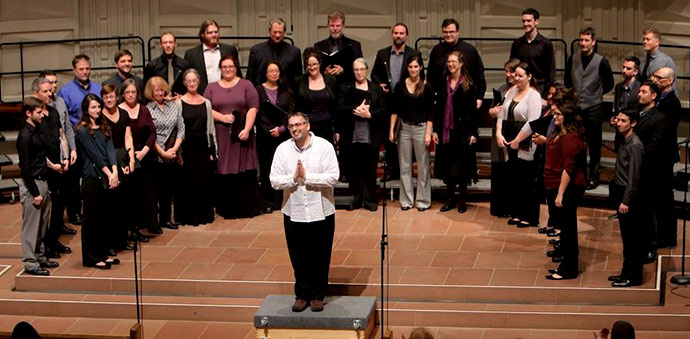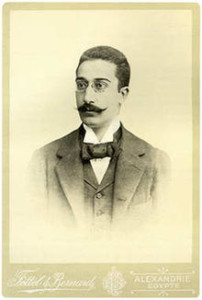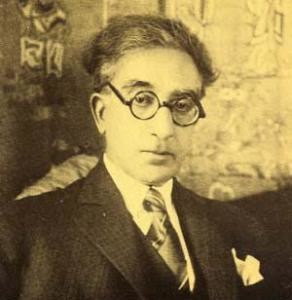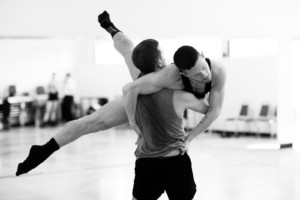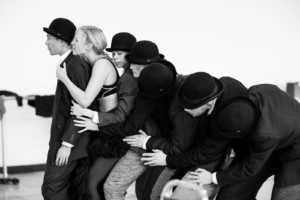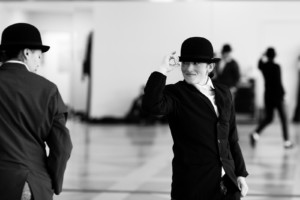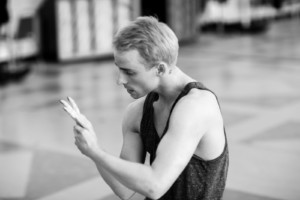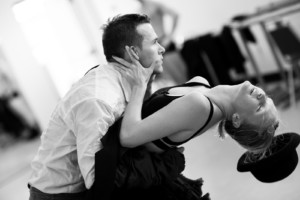Although I’m loath to repeat myself with regard to Whim W’Him—as is the company in the work it presents—it makes sense to reintroduce composer Eric Banks, The Esoterics, and the music for the new Approaching Ecstasy by revisiting a post from five years ago. Many of the same points need making now too (though with a bit of updated commentary plus all new photos), and they were expressed pretty clearly then, so why not?
[Brackets denote changes from the earlier post]
Eric has always liked puzzles, codes, other languages. “In his composition,” as his website bio notes, he “is drawn to ideas that are ‘esoteric’ in origin, and chooses to uncover and elucidate texts and concepts that are undiscovered, under-represented, or not easily decipherable to most.” In developing his repertoire of mostly a cappella choral music, especially for his skilled and innovative choir The Esoterics, Eric “has been able to combine his interests in poetry, philosophy, classical civilization, comparative religion, ancient melody, and social justice.” The love poetry of C.P. Cavafy as a subject for Eric’s composition could hardly be a more perfect fit.
In the Frontispiece to the Approaching Ecstasy score, Eric [wrote] that for this piece he “set 18 of Cavafy’s highly personal poems about his life as a gay man in Egypt over a century ago. In these poems, there are vivid portraits of his lovers, depictions of his secret life as well as that of his friends, and expressions of fear, hope, remembered love, and excruciating beauty.”
In a conversation [that he and I had before the original AE production, even before the first dance rehearsals had begun], Eric remarked that “new music tends to be of one of 2 types—the kind that soothes and the kind that challenges. Cavafy’s poetry makes for a great combination.” It is in a difficult foreign language and unfamiliar to most of us, yet incredibly strong and emotional in its appeal. The love poems, chosen for this piece by Eric and Whim W’Him artistic director/choreographer Olivier Wevers, are straightforwardly sensual. Their overt meaning is seldom veiled or obscure. Yet a great deal of subtlety is required of music or dance that hopes to plumb their layered, even contradictory complexities:
- The trysts or observed moments or persons that these poems celebrate and commemorate are mainly from the past—often very long before. Thus, the poems become as much exercises in memory as direct, urgent descriptions of a particular moment. And memory itself can at once express melancholy at the passage of time and burnish what is recalled, even to the point of reinvention.
- Connections between corporeal beauty and art can come out as inspiration, sublimation, transcendence, regret.
- The poet’s frustration at hiding his true nature is mitigated by his rather surprisingly hopeful—and prescient—conviction that some day [such subterfuges] will no longer be necessary.
- Cavafy’s sadness at his walled in, curtailed existence is to some extent balanced by a certain exquisite joy he takes in secrecy: danger heightens pleasure.
The music of Approaching Ecstasy is prodigiously intricate in construction.
The piece [was] 86 minutes long [though it is now a few minutes shorter] without intermission. In various combinations, a choir of 40 [now 33] will perform the 18 poems in 2 languages. The first 9 of the poems will be sung first in English, then Greek. In the second half of the program, the order is reversed: the larger Greek-singing choir, chamber ensemble and dancers are to be deployed first, then followed by the English version. In addition there are an instrumental Prologue, Intermezzo, and Epilogue. [This language order is now reversed, however, so that the Greek version comes first for the first 9 poems, then English leads for the last 9.]
The plain English words of each poem [is] sung a cappella by some or all singers of a smaller group of 16 out of the 40, and are “scored to be clearly and homophonically declaimed [in unison].”
The Greek versions, by contrast, [are] less literal or narrative, rendered far more impressionistically, as they open out into dance, instrumental music (string quartet and harp), and voices in various groupings. [For the new AE, dance is no longer sequestered in the Greek versions of the poems. The whole interplay of dance and song is considerably richer and more fluid than the first time round.] In the process, every permutation of pitch is employed. As Eric says, “this piece traverses the circle-of-fifths 3 times, employing each key signature in one of 3 Arabic maqamat (equivalent to the Aeolian mode, Phrygian mode, and Suzidil or Shahnaz).” He add[ed] with a smile, “No harmonic stone is left unturned.”
The Greek sections also are far more complicated rhythmically. While the declaimed English translations are always in 4/4 time, Eric has “borrowed from Arabic meters as well,” for the Greek versions, where the time signatures form a palindrome. In the Greek, starting and ending poems (“Candles” and “Shadows”) are in 17/8 time, then the piece works in from both ends toward the middle, where the key poems “Walls” and “Windows”—both in 7/8 time and [together] at the centerpoint of the piece—express Cavafy’s sense of being crushed down and imprisoned by the circumstances of his life.
A very intricate structure, as I said. And frankly, on the basis of Eric’s explanations alone of all symmetries and clever devices built into Approaching Ecstasy, I would have feared that this piece might be too cerebral, its structure ‘too clever by half.’ So I am very glad I listened to the music first and heard him talk personally about his own approach to portraying the particulars of Cavafy’s ecstasy. The multifaceted [construction and] textures of this work certainly add intellectual depth and interest to the music, but because Eric began his composition of each poem by concentrating on its feeling, finding an image or mood—a glowing lamp, a sense of opulence—the effect of the whole [is] immediate and visceral as well, creating out of complexity a [music/dance] work of great emotional simplicity and truth.
Photo Credit: All dance images by Bamberg Fine Art Photography
Up next: how do you integrate 33 singers, 4 string players, 1 harpist, 1 conductor & 7 dancers?
